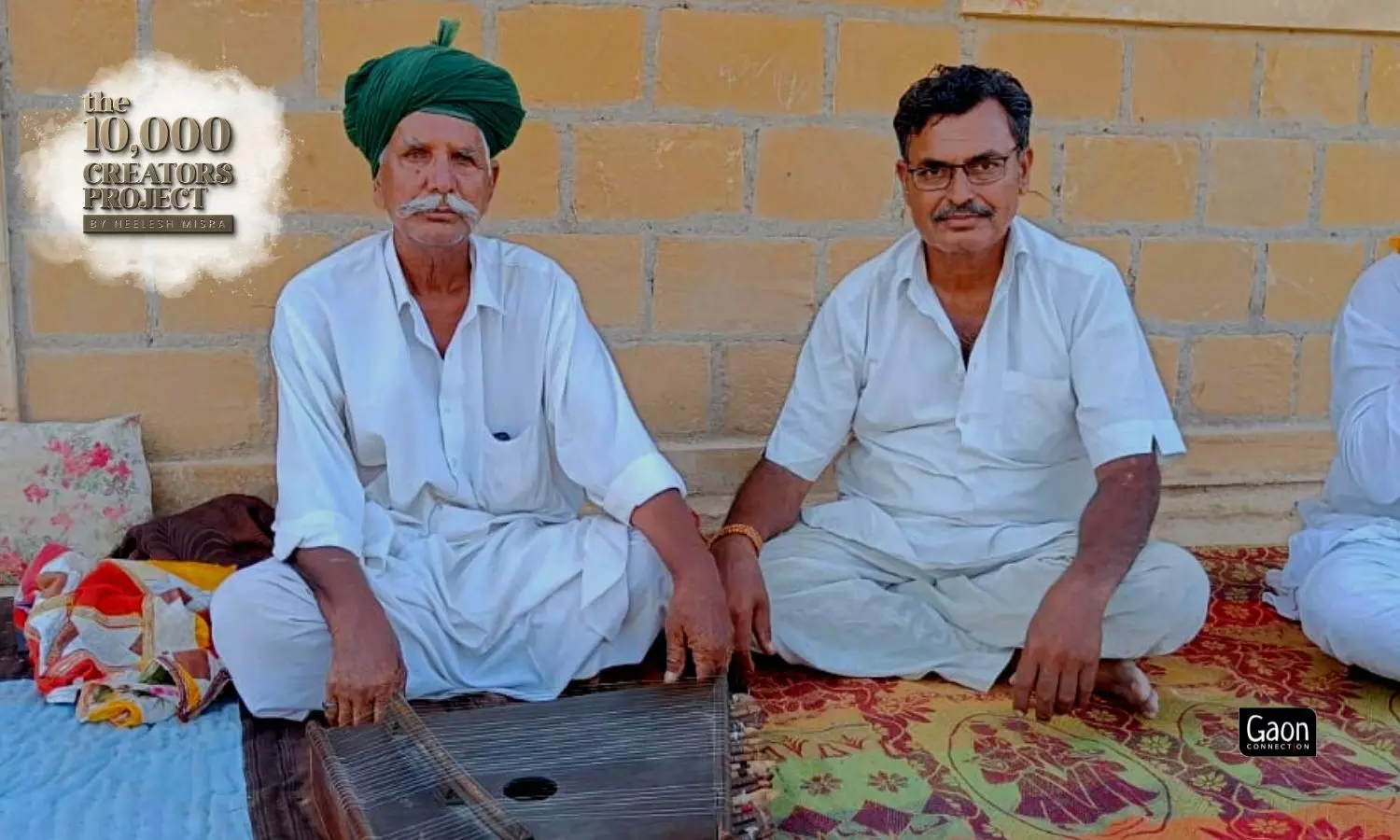Will the Sur Mandal Fall Silent? — A Musician and a Craftsman in Jaisalmer Worry
Chanan Khan is perhaps one of the last musicians who can play the Sur Mandal in the desert district of Rajasthan. Artists like him, and Kishanlal Suthar who crafts this musical instrument are fast disappearing.
 Kuldeep Chhangani 11 Oct 2023 6:29 AM GMT
Kuldeep Chhangani 11 Oct 2023 6:29 AM GMT
 Sur Mandal is slowly going silent and Chaandan Khan's life is but a travesty of how his ancestors lived with royal patronage. All Photos by Kuldeep Chhangani.
Sur Mandal is slowly going silent and Chaandan Khan's life is but a travesty of how his ancestors lived with royal patronage. All Photos by Kuldeep Chhangani. Kanoi (Jaisalmer), Rajasthan
Ever since he learnt to play the Sur Mandal from his chacha (uncle), 75-year-old Chanan Khan has devoted his entire life to this musical instrument.
But, as he ages, Chanan Khan who lives in Kanoi village in the desert district of Jaisalmer, is worried.
"Though I am teaching the Sur Mandal to my son, I want to teach it to more musicians. I don’t think there’s anyone else left in and around my village who can play this instrument,” Khan told Gaon Connection.
Somewhat similar is the predicament of 54-year-old Kishanlal Suthar, who is perhaps the last remaining craftsman in the region who knows how to make a Sur Mandal, which is also known as Swarmandal.
It is not just the Sur Mandal musicians who are disappearing, but even the craftsmen like Suthar who make the instrument. Suthar (R) and Chanan Khan (L).
Just like Khan, Suthar also lives in Kanoi village. “Since barely anybody knows how to play Sur Mandal, nobody ever buys it,” the craftsman lamented.
Sur Mandal is basically a small harp which is most commonly used as an accompanying instrument for vocal Indian classical music. It is part of the culture of north India and is used in concerts to accompany vocal music. The name combines Sanskrit words svara (notes) and maṇḍala (circle), representing its ability to produce many notes.
Sur Mandal is a small harp which is most commonly used as an accompanying instrument for vocal Indian classical music.
“Making a Sur Mandal is a laborious task.. It needs care and precision and a lot of patience which youngsters lack. A total of 36 wires of iron have to be tied to the frame with a morni [knob] on top of it. My own son refuses to learn how to make it. He says there is nothing in it for him,” said craftsman Suthar.
Khan, the musician, reminisced all those times he had played Sur Mandal at various concerts that were organised at offshore locations. He said that he has played it in Russia, The Netherlands, and Germany.
“Even now, I do riyaaz (practice) every morning. My Sur Mandal is my life. I am proud that I could play the instrument for the music of my Managaniar community,” he said with pride.
The Manganiar Muslim community, which resides across the Thar desert, has enjoyed the patronage of Rajput Hindu rulers for many centuries. The songs of the Manganiars are all about the valour of Rajput warriors and they often resound with inter-faith harmony.
But the Sur Mandal is slowly going silent. Khan’s life is but a travesty of how his ancestors lived, sought after and with royal patronage.
Today, the famed musician has to depend on the largess of foreigners and other tourists who visit Jaisalmer in Rajasthan.
Also Read: The Fading Glory of Bhand Pather, Kashmir’s Traditional Folk Theatre
It is not just the Sur Mandal musicians who are disappearing, but even the craftsmen like Suthar who make the instrument.
“It takes 15 days to craft it and it costs about Rs 20,000. No one is willing to pay so much for it. I prefer to make furniture as it sells better,” Suthar said nonchalantly.
Rajasthan’s Scheme To Help Artists
Rajasthan’s chief minister, Ashok Gehlot launched the Lok Kalakar Protsahan Yojana in August this year, which is aimed at providing an allowance worth Rs 5,000 to the music artists to buy musical instruments.
The scheme also will ensure musicians get at least a 100 days of paid concerts in a year where they can perform. Under this scheme, the state government is supposed to pay Rs 500 per day per family to folk artists.
This scheme is along the lines of the Mahatma Gandhi National Rural Employment Guarantee Act [MGNREGA] which promises 100 days of employment in a year for the rural residents.
The artists are required to apply for a ‘kalakaar card’ which will officially make them eligible for state benefits.
“We have applied for it but haven’t received it yet. The card will be of great help for families who struggle to make ends meet,” said Khan. None of the villagers from the Mangania community in Khan’s village has been able to get the card so far.
#Rajasthan #SurMandal
More Stories




